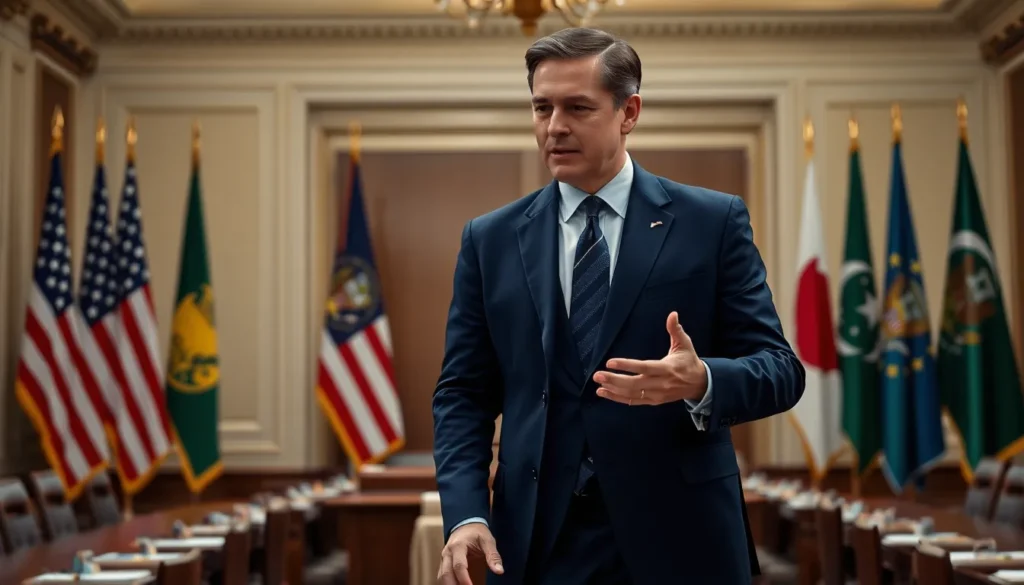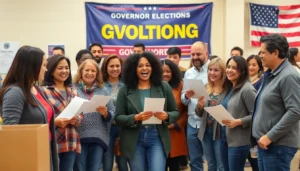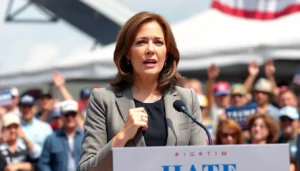In an increasingly interconnected world, diplomatic practice plays a crucial role in shaping international relations. It’s the art of negotiation and communication that enables nations to address conflicts, forge alliances, and promote mutual interests. Understanding the nuances of diplomatic practice is essential for anyone interested in global affairs, as it influences everything from trade agreements to peace treaties.
As countries navigate complex political landscapes, diplomats serve as the bridge between cultures and governments. They employ various strategies to build trust and foster cooperation, often operating behind the scenes. By exploring the principles and techniques of diplomatic practice, one can gain insight into how nations interact and resolve their differences, ultimately contributing to a more stable and peaceful world.
Table of Contents
ToggleOverview of Diplomatic Practice
Diplomatic practice refers to the processes and methods diplomats use to represent their country and negotiate on its behalf. Diplomacy encompasses formal discussions, treaties, and informal meetings, all aimed at fostering international cooperation and addressing disputes.
Key elements of diplomatic practice include:
- Negotiation Techniques: Diplomats employ various negotiation strategies to achieve their countries’ objectives. Techniques can range from bargaining to consensus-building, tailored to specific contexts.
- Cultural Understanding: Successful diplomacy relies on knowledge of different cultures. Diplomats study language, customs, and values to facilitate effective communication and build relationships.
- Protocol and Etiquette: Adhering to established protocols ensures smooth interactions. Proper etiquette demonstrates respect and professionalism, essential in high-stakes negotiations.
- Conflict Resolution: Diplomacy focuses on addressing conflicts through dialogue. Effective diplomats identify underlying issues, engage stakeholders, and seek mutual compromises.
- International Law: Diplomats operate within frameworks of international law, which govern relations between states. Understanding legal principles helps diplomats navigate complex issues like sovereignty and human rights.
- Public Diplomacy: Engaging with foreign publics enhances a country’s image and fosters goodwill. Diplomats use media, cultural exchanges, and educational programs to strengthen relationships beyond governmental ties.
- Multilateral Diplomacy: Involving multiple countries, multilateral diplomacy addresses global challenges, such as climate change and security. Diplomats participate in international organizations, facilitating collective decision-making.
Understanding these elements enhances insight into how diplomatic practice shapes global interactions, promotes stability, and resolves conflicts.
Historical Context of Diplomatic Practice

Diplomatic practice has deep historical roots, evolving significantly from ancient times to the present. Understanding this evolution is crucial to grasping how current diplomatic frameworks operate.
Evolution Through the Centuries
Diplomacy has transformed over centuries, adapting to changing political landscapes and technological advancements.
- Ancient Civilizations: Early forms of diplomacy emerged in ancient Egypt and Mesopotamia, where envoys facilitated treaties and trade agreements.
- Classical Era: Greek city-states prioritized alliances for mutual defense and economic benefit, using messengers to communicate strategic interests.
- Medieval Period: The Catholic Church played a pivotal role in European diplomacy, mediating disputes and establishing protocols still relevant today.
- Renaissance: With the rise of nation-states, increased emphasis on permanent ambassadors and the establishment of diplomatic missions took place, shaping modern diplomatic norms.
- 19th Century: The Congress of Vienna (1815) marked the emergence of multilateral diplomacy, focusing on collective security and the balance of power.
- 20th Century: World Wars catalyzed the development of international organizations like the League of Nations and later the United Nations, prioritizing diplomacy for global peacekeeping.
Key Historical Figures
Several influential figures significantly impacted the course of diplomatic practice throughout history.
- Niccolò Machiavelli: His works, particularly “The Prince,” provided insights into statecraft and the pragmatic use of power in diplomacy.
- Talleyrand: As a master diplomat during the French Revolution and Napoleonic Era, Talleyrand exemplified the art of negotiation and alliance.
- Henry Kissinger: His role in U.S. foreign policy during the 1970s, particularly with China, showcased the importance of strategic diplomacy in shaping global relations.
- Dag Hammarskjöld: As the second Secretary-General of the United Nations, he emphasized the need for multilateral diplomacy and conflict resolution.
- Madeleine Albright: Her tenure as U.S. Secretary of State highlighted the importance of diplomacy in addressing human rights and international cooperation.
These historical contexts and figures illustrate how diplomatic practices have developed and shaped modern international relations.
Core Principles of Diplomatic Practice
Core principles serve as the foundation for effective diplomatic practice. Understanding these principles enhances the ability to navigate complex international relations.
Sovereignty and International Law
Sovereignty refers to a state’s authority over its territory and political independence. Respecting sovereignty is vital in diplomatic interactions, ensuring that negotiations honor each nation’s rights. International law, established through treaties and conventions, governs the behavior of states and sets standards for diplomacy. Principles such as non-interference, territorial integrity, and self-determination shape how diplomacy is conducted. Diplomats must navigate these legal frameworks to advocate for their nation’s interests while adhering to established laws that promote global order.
Negotiation and Mediation Techniques
Negotiation techniques play a crucial role in resolving disputes and achieving diplomatic objectives. Effective negotiators employ strategies such as active listening, finding common ground, and leveraging persuasive communication to facilitate discussions. Mediation serves as a valuable tool, allowing a neutral third party to assist conflicting parties in reaching a consensus. Successful mediation often involves establishing trust, maintaining confidentiality, and ensuring that proposals are equitable. Diplomats must blend negotiation and mediation skills to address challenges, foster collaboration, and achieve lasting agreements.
Challenges in Diplomatic Practice
Diplomatic practice faces numerous challenges that can hinder effective communication and negotiation. These challenges stem from contemporary global issues and the evolving role of technology in diplomacy.
Contemporary Global Issues
Contemporary global issues significantly impact diplomatic practice. Frequent conflicts, economic disparities, and policies related to climate change create a complex environment for diplomats.
- Geopolitical Tensions: Heightened tensions among nations, such as those seen between the U.S. and China, complicate negotiations and hinder collaboration on critical global challenges.
- Ethnic and National Conflicts: Ethnic rivalries in regions like the Balkans or the Middle East often disrupt diplomatic efforts, necessitating skilled mediators to bridge divides.
- Economic Inequality: Economic disparities influence diplomatic relations, where richer nations may face pressure to assist developing countries, complicating negotiations on trade and aid.
- Climate Change: Rising environmental concerns necessitate thorough discussions among nations to address shared issues like pollution, resource management, and sustainable development.
The Role of Technology in Diplomacy
Technology’s rapid advancement alters diplomatic dynamics, presenting both opportunities and challenges.
- Digital Communication: Diplomatic communication relies heavily on digital platforms, facilitating rapid information exchange. However, misinformation and cyber threats complicate trust-building efforts.
- Social Media Influence: Social media shapes public perception of diplomatic actions, where crises can escalate quickly, demanding immediate responses from diplomats to manage public relations.
- Data Security: Sensitive diplomatic communications require robust cybersecurity measures. Breaches can lead to diplomatic fallout, undermining trust between nations.
- Virtual Meetings: The rise of virtual diplomacy allows for broader participation, particularly in times of global crises. However, it poses challenges in conveying nuances and building personal rapport.
These challenges necessitate adaptability, creativity, and resilience from diplomats as they navigate the evolving landscape of international relations.
Case Studies of Diplomatic Practice
Several case studies illustrate effective and ineffective diplomatic practices, showcasing both successful events and valuable lessons learned from failures.
Successful Diplomatic Events
- Camp David Accords (1978)
The Camp David Accords marked a significant milestone in Middle Eastern diplomacy. U.S. President Jimmy Carter facilitated negotiations between Egyptian President Anwar Sadat and Israeli Prime Minister Menachem Begin. The accords established a framework for peace and led to Egypt recognizing Israel, demonstrating the impact of sustained dialogue and compromise.
- Oslo Accords (1993)
The Oslo Accords represented a breakthrough in Israeli-Palestinian relations. Negotiated under the guidance of U.S. diplomats, these agreements aimed to address long-standing territorial disputes. Both sides engaged in direct negotiations, illustrating the importance of mutual recognition and incremental progress in diplomacy.
- Singapore Summit (2018)
The historic summit between U.S. President Donald Trump and North Korean leader Kim Jong-un in Singapore exemplified modern diplomatic efforts to address nuclear proliferation. The meeting underscored how personal diplomacy can break years of stalemate, emphasizing the need for open communication channels.
Lessons Learned from Failures
- Cuban Missile Crisis (1962)
The Cuban Missile Crisis posed significant risks due to miscommunication and lack of clarity in diplomatic channels. Although ultimately resolved, the crisis highlighted the dangers of escalating tensions and the necessity for back-channel communication to avert conflicts.
- Treaty of Versailles (1919)
The Treaty of Versailles serves as a cautionary tale about punitive diplomacy. Imposed harsh penalties on Germany post-World War I, fostering resentment and instability. The treaty emphasizes the importance of equitable solutions to prevent future conflicts.
- Rwandan Genocide (1994)
The failure of international diplomatic responses during the Rwandan Genocide illustrates the dire consequences of inaction. Despite early warnings, global powers hesitated to intervene. This tragedy underscores the need for timely and decisive diplomatic action in preventing humanitarian crises.
These case studies reveal essential strategies and pitfalls in diplomatic practice that shape modern international relations.
Diplomatic practice remains a cornerstone of international relations. Its evolving nature reflects the complexities of a world marked by rapid change and interconnectedness. As diplomats adapt to new challenges and leverage technology, their role in fostering understanding and cooperation becomes even more critical.
The lessons drawn from historical successes and failures underscore the importance of effective communication and cultural sensitivity. By embracing these principles, diplomats can navigate the intricate web of global politics and contribute to a more peaceful and stable world. Ultimately, the future of diplomacy hinges on the ability to build bridges and foster collaboration among nations.





